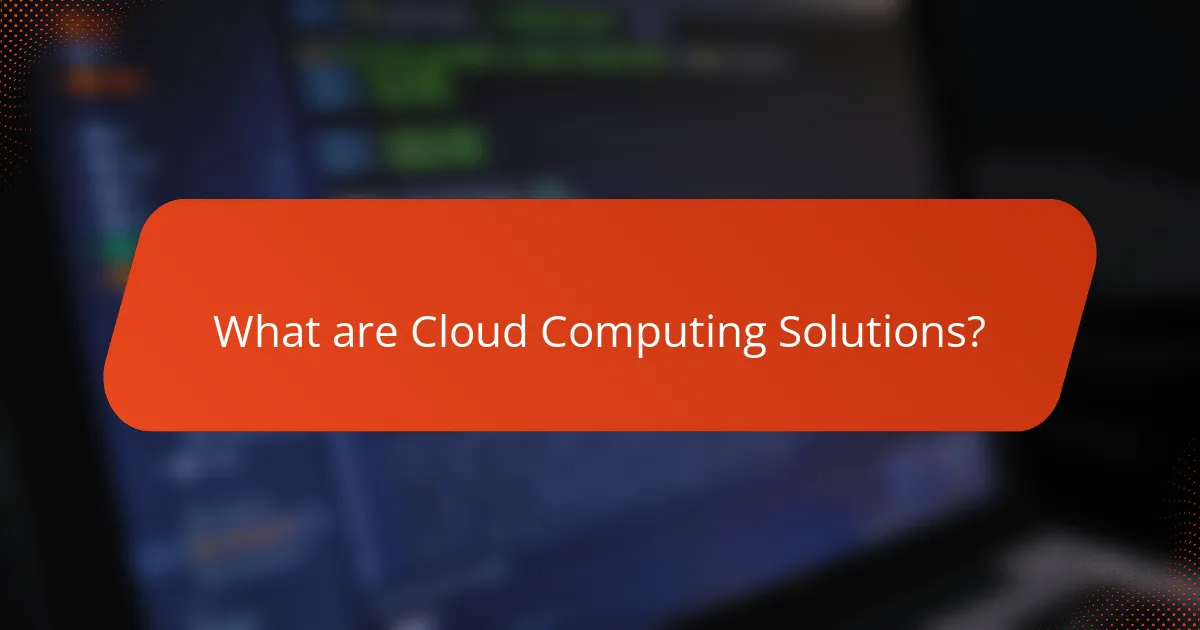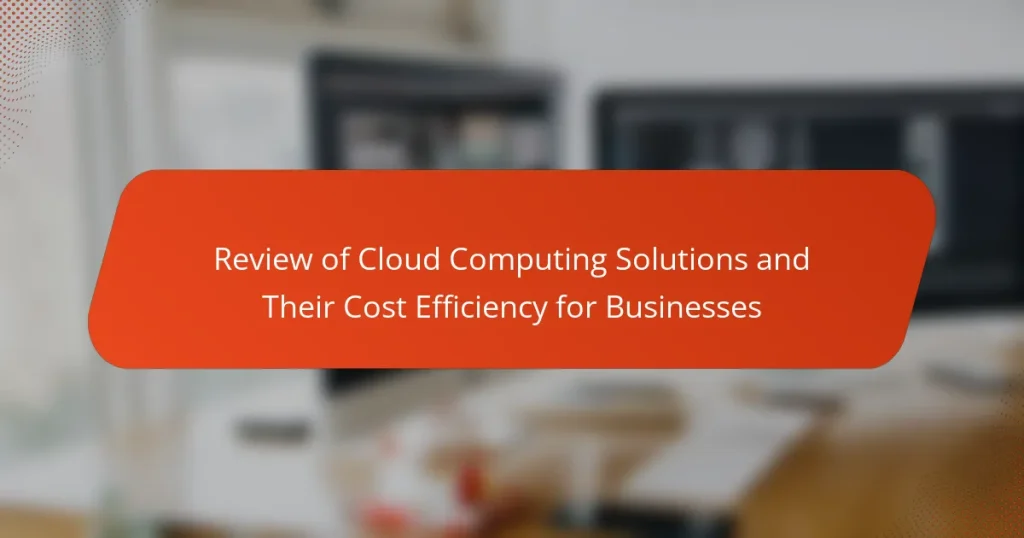Cloud computing solutions refer to services that provide essential computing resources, such as storage, processing power, and applications, via the internet. These services, categorized into Infrastructure as a Service (IaaS), Platform as a Service (PaaS), and Software as a Service (SaaS), enable businesses to access on-demand resources, significantly reducing the need for physical infrastructure. The article highlights the growing global cloud services market, projected to reach $482 billion by 2022, and emphasizes the importance of cost efficiency in cloud computing. Key strategies for optimizing costs include selecting appropriate pricing models, monitoring usage, leveraging auto-scaling features, implementing tagging for resource tracking, and conducting regular audits to identify savings opportunities. By adopting these best practices, organizations can enhance operational efficiency and focus on innovation.

What are Cloud Computing Solutions?
Cloud computing solutions are services that provide computing resources over the internet. These resources include storage, processing power, and applications. Businesses can access these services on-demand, reducing the need for physical infrastructure. Major types of cloud computing solutions are Infrastructure as a Service (IaaS), Platform as a Service (PaaS), and Software as a Service (SaaS). According to a report by Gartner, the global cloud services market is expected to reach $482 billion by 2022. This growth highlights the increasing reliance on cloud solutions for operational efficiency.
How do Cloud Computing Solutions function?
Cloud computing solutions function by delivering computing resources over the internet. These resources include servers, storage, databases, networking, software, and analytics. Users can access these services on-demand, allowing for flexibility and scalability. Providers host the infrastructure in data centers, ensuring high availability and reliability.
Data is processed and stored remotely, reducing the need for local hardware. This model allows businesses to pay only for what they use, optimizing cost efficiency. Various service models exist, such as Infrastructure as a Service (IaaS), Platform as a Service (PaaS), and Software as a Service (SaaS). Each model provides different levels of control and management.
Cloud computing solutions also enable collaboration by allowing multiple users to access and work on data simultaneously. Security measures are implemented to protect data, including encryption and access controls. The global market for cloud computing is projected to reach $832.1 billion by 2025, demonstrating its growing importance for businesses.
What are the key components of Cloud Computing Solutions?
Key components of Cloud Computing Solutions include infrastructure, platforms, and software. Infrastructure as a Service (IaaS) provides virtualized computing resources over the internet. This includes servers, storage, and networking capabilities. Platform as a Service (PaaS) offers a framework for developers to build applications without managing underlying infrastructure. Software as a Service (SaaS) delivers software applications over the internet on a subscription basis. Additionally, cloud storage is essential for data management and accessibility. Security measures, such as encryption and access controls, are vital to protect data. Lastly, cloud management tools facilitate monitoring and optimization of cloud resources. These components together create a comprehensive cloud solution for businesses.
How do different components interact within Cloud Computing Solutions?
Different components within Cloud Computing Solutions interact through a layered architecture. This architecture includes front-end interfaces, back-end servers, and a network. Users access cloud services via front-end interfaces like web browsers or applications. The front end communicates with back-end servers over the internet. These servers manage data storage, processing, and application hosting.
Data is transferred between users and servers using APIs (Application Programming Interfaces). This interaction enables seamless data exchange and functionality. Virtualization technology allows multiple virtual machines to run on a single physical server. This optimizes resource utilization and scalability.
Cloud service models, such as IaaS, PaaS, and SaaS, define how these components interact. IaaS provides virtualized computing resources, PaaS offers a platform for application development, and SaaS delivers software over the internet. Each model has distinct roles but works together to deliver comprehensive cloud solutions.
What types of Cloud Computing Solutions are available?
There are three main types of cloud computing solutions: Infrastructure as a Service (IaaS), Platform as a Service (PaaS), and Software as a Service (SaaS). IaaS provides virtualized computing resources over the internet. Users can rent servers, storage, and networking. PaaS offers a platform allowing developers to build, deploy, and manage applications without managing the underlying infrastructure. SaaS delivers software applications over the internet on a subscription basis. These solutions enable businesses to reduce costs and increase scalability. According to Gartner, cloud services are projected to grow by 18% in 2021, highlighting their increasing adoption.
What are the differences between public, private, and hybrid clouds?
Public clouds are services offered over the internet to multiple customers. They provide scalability and cost-effectiveness. Private clouds are exclusive to a single organization. They offer enhanced security and control. Hybrid clouds combine both public and private clouds. They allow data and applications to be shared between them. Public clouds are managed by third-party providers. Private clouds are typically managed internally or by a third party. Hybrid clouds can be tailored to meet specific business needs. Each type of cloud has distinct advantages based on security, cost, and control.
How do SaaS, PaaS, and IaaS fit into Cloud Computing Solutions?
SaaS, PaaS, and IaaS are key models within cloud computing solutions. SaaS, or Software as a Service, delivers software applications over the internet. Users access these applications via a web browser without needing to install them locally. PaaS, or Platform as a Service, provides a platform for developers to build, deploy, and manage applications. It simplifies the development process by offering tools and services. IaaS, or Infrastructure as a Service, offers virtualized computing resources over the internet. It enables businesses to rent servers, storage, and networking capabilities. Together, these models provide flexible, scalable, and cost-effective solutions for businesses. They allow companies to reduce IT costs and focus on core operations. According to a report by Gartner, cloud services are projected to grow to $482 billion by 2022, highlighting their increasing adoption in business environments.

Why is Cost Efficiency Important for Businesses Using Cloud Computing?
Cost efficiency is crucial for businesses using cloud computing because it directly impacts their bottom line. Cloud computing enables businesses to reduce capital expenditures on hardware and infrastructure. Instead of investing heavily in physical servers, companies can utilize cloud services on a pay-as-you-go basis. This model allows businesses to scale resources according to their needs, avoiding over-provisioning. A report by Gartner indicates that organizations can save up to 30% on IT costs by migrating to the cloud. Additionally, cloud solutions often include maintenance and security, further lowering operational costs. By optimizing resource allocation, businesses can focus on innovation and growth rather than managing IT assets.
How can Cloud Computing Solutions reduce operational costs?
Cloud computing solutions can reduce operational costs by eliminating the need for physical hardware. Businesses no longer need to invest in expensive servers and maintenance. Instead, they can utilize scalable cloud resources on a pay-as-you-go basis. This model allows companies to pay only for what they use. According to a report by Gartner, organizations can save up to 30% on IT costs by migrating to the cloud. Additionally, cloud solutions reduce energy consumption associated with running on-premises data centers. The flexibility of cloud services also leads to faster deployment and lower labor costs. Overall, these factors contribute significantly to cost savings for businesses.
What specific cost-saving features do Cloud Computing Solutions offer?
Cloud computing solutions offer several specific cost-saving features. First, they provide pay-as-you-go pricing models. This allows businesses to only pay for the resources they use. Second, cloud solutions eliminate the need for extensive on-premises hardware. This reduces capital expenditures significantly. Third, they offer scalability options. Businesses can easily scale resources up or down based on demand, optimizing costs. Fourth, cloud services often include built-in redundancy and disaster recovery. This minimizes downtime costs. Additionally, they reduce energy costs associated with running physical servers. A study by Gartner found that organizations can save up to 30% on IT costs by adopting cloud solutions.
How does scalability in Cloud Computing impact cost efficiency?
Scalability in Cloud Computing significantly enhances cost efficiency. It allows businesses to adjust resources according to demand. This flexibility prevents over-provisioning and under-utilization of resources. Companies only pay for what they use, leading to reduced operational costs. For example, a study by Gartner found that businesses can save up to 30% on IT costs through effective scalability. Additionally, scalable solutions support growth without the need for substantial upfront investment. As demand increases, resources can be allocated seamlessly, maintaining performance without incurring unnecessary expenses. Thus, scalability directly contributes to optimized cost management in cloud environments.
What are the potential hidden costs of Cloud Computing Solutions?
Potential hidden costs of cloud computing solutions include data transfer fees, vendor lock-in, and unexpected scaling costs. Data transfer fees can arise when moving data in and out of the cloud. These fees can accumulate quickly, especially with large datasets. Vendor lock-in occurs when businesses become dependent on a specific cloud provider, making it costly to switch providers. Unexpected scaling costs can happen when usage exceeds initial estimates, leading to higher monthly bills. Additional costs may also include training staff and integrating existing systems with cloud solutions. Compliance and security measures may require extra investments, further increasing overall expenses. According to a study by the International Data Corporation, 30% of cloud users report unexpected costs, highlighting the importance of thorough planning.
What should businesses consider when evaluating the total cost of ownership?
Businesses should consider both direct and indirect costs when evaluating the total cost of ownership (TCO). Direct costs include initial purchase price, installation fees, and recurring subscription costs. Indirect costs encompass maintenance, support, training, and potential downtime.
Additionally, businesses must assess the lifespan of the solution and any potential upgrades. The environmental impact and energy consumption of cloud solutions can also influence TCO. Evaluating scalability and flexibility is crucial, as these factors affect future costs.
According to a study by Gartner, organizations can save up to 30% on TCO by adopting cloud solutions compared to traditional on-premises infrastructure. This highlights the importance of a comprehensive evaluation of all cost factors associated with cloud computing.
How can businesses avoid unexpected expenses with Cloud Computing?
Businesses can avoid unexpected expenses with cloud computing by implementing careful planning and monitoring. First, they should conduct a thorough assessment of their cloud needs. This includes understanding required resources and expected usage patterns. Second, businesses should choose a cloud pricing model that aligns with their usage. Pay-as-you-go models can lead to unexpected costs if usage spikes. Third, they should set up budget alerts to monitor spending in real-time. This allows for immediate action if costs exceed expectations. Fourth, regular audits of cloud usage can identify underutilized resources. Optimizing these resources can lead to significant savings. Finally, businesses should negotiate contracts with cloud providers to ensure flexibility and favorable terms. These steps collectively help mitigate the risk of unexpected expenses in cloud computing.

What are the best practices for maximizing cost efficiency in Cloud Computing?
To maximize cost efficiency in cloud computing, organizations should implement several best practices. First, they should choose the right pricing model based on usage patterns. Pay-as-you-go models can reduce costs for variable workloads. Second, organizations must monitor and analyze cloud usage regularly. This helps identify underutilized resources that can be downsized or terminated. Third, leveraging auto-scaling features can optimize resource allocation based on demand. This ensures that businesses only pay for what they use.
Additionally, implementing tagging strategies for resources aids in tracking costs effectively. This enables better budgeting and accountability. Fourth, organizations should consider reserved instances for stable workloads. This can lead to significant savings compared to on-demand pricing. Finally, conducting regular audits of cloud expenses can uncover hidden costs and opportunities for savings. According to a report by Flexera, 30% of cloud spending is wasted, highlighting the importance of these practices.
How can businesses effectively choose the right Cloud Computing Solution?
Businesses can effectively choose the right Cloud Computing Solution by assessing their specific needs and objectives. They should evaluate factors such as scalability, security, and compliance requirements. Cost analysis is crucial; businesses must compare pricing models and total cost of ownership. Performance metrics like uptime and speed should also be considered. Additionally, integration capabilities with existing systems are essential for seamless operations. Customer support and service level agreements (SLAs) can impact long-term satisfaction. Research indicates that 94% of businesses report improved security after adopting cloud solutions, highlighting the importance of security in decision-making.
What factors should be considered when selecting a Cloud provider?
Key factors to consider when selecting a Cloud provider include security, compliance, and performance. Security measures must be robust to protect sensitive data. Compliance with regulations like GDPR is essential for legal operations. Performance metrics such as uptime and response times impact user experience. Cost structures should be transparent and align with budget constraints. Scalability options are crucial for future growth. Customer support quality can affect service reliability. Provider reputation and industry experience can indicate reliability. Lastly, integration capabilities with existing systems streamline operations.
How can businesses align their Cloud strategy with their financial goals?
Businesses can align their Cloud strategy with financial goals by assessing cost structures and ROI. They should evaluate existing spending on IT infrastructure and compare it with potential savings from cloud adoption. Financial forecasting tools can help predict the impact of cloud investments on cash flow. Additionally, aligning cloud service models with business needs ensures optimal resource allocation. Regularly reviewing cloud usage metrics aids in identifying inefficiencies. According to a 2021 report by Gartner, companies can save up to 30% on IT costs by shifting to cloud solutions. This data supports the alignment of cloud strategies with financial objectives.
What tips can help businesses optimize their Cloud Computing costs?
To optimize Cloud Computing costs, businesses should regularly assess their usage and adjust resources accordingly. Monitoring cloud resource consumption helps identify underutilized services. Implementing auto-scaling can ensure resources match demand, reducing waste. Utilizing reserved instances can lead to significant savings for predictable workloads. Leveraging multi-cloud strategies allows businesses to select cost-effective services from various providers. Employing cloud cost management tools enhances visibility into spending patterns. Regularly reviewing and optimizing cloud architectures can also reduce unnecessary expenses. According to a report by Flexera, 93% of organizations experience overspending on cloud services, emphasizing the need for diligent cost management.
What monitoring tools are available to track Cloud spending?
Monitoring tools available to track Cloud spending include AWS Cost Explorer, Azure Cost Management, and Google Cloud Billing. AWS Cost Explorer allows users to visualize their spending patterns and forecast future costs. Azure Cost Management provides insights into resource usage and cost allocation. Google Cloud Billing offers detailed reports on spending and budget alerts. These tools help businesses optimize their cloud expenditures effectively.
How can businesses implement cost management strategies in Cloud Computing?
Businesses can implement cost management strategies in cloud computing by utilizing cost monitoring tools and optimizing resource allocation. Cost monitoring tools provide real-time insights into cloud spending. This allows businesses to track expenses and identify areas for savings. Optimizing resource allocation involves adjusting cloud resources based on demand. Businesses can scale services up or down to match usage patterns.
Implementing budgets and alerts can also help manage costs effectively. Setting budgets allows companies to control spending limits. Alerts notify businesses when costs approach these limits. Regularly reviewing cloud usage and costs is essential for ongoing management. This practice helps in identifying underutilized resources that can be downsized or eliminated.
According to a report from Gartner, organizations can save up to 30% on their cloud spending by optimizing their cloud usage. This statistic underscores the importance of effective cost management strategies in cloud computing.
Cloud computing solutions are internet-based services that provide businesses with computing resources, including storage, processing power, and applications, on a pay-as-you-go basis. This article reviews the various types of cloud computing solutions—Infrastructure as a Service (IaaS), Platform as a Service (PaaS), and Software as a Service (SaaS)—and their role in enhancing cost efficiency for organizations. Key components, operational functions, and the interaction between different cloud elements are examined, alongside the importance of scalability and cost management strategies. Additionally, the article highlights potential hidden costs and best practices for optimizing cloud expenditures to align with financial goals.




